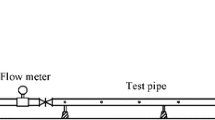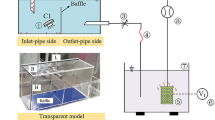Abstract
Deposition particles can lead to blockage, odor, and corrosion of pipes, and the deposition process of suspended particles is particularly complicated. In order to quantify the deposition process of suspended particles and mastered the critical conditions for the deposition in storm drainage, the process was simulated experimentally, and the deposition states of suspended particles under the different roughness of pipe wall, particle size, and density were analyzed. Two mathematical models of deposition critical velocity and easy deposition velocity were established. Results showed that with the increase of particle size and density, the gravity of particles increased and deposition was more likely to occur. In the rough pipeline, the kinetic energy consumption of water flow increased, the ability to carry particles was weakened, and the deposition rate would increase accordingly. The higher the flow velocity, the lower the deposition rate. The deposition states of particles in the pipeline could be divided into three types according to the deposition rates: “no deposition,” “minor deposition,” and “bulk deposition.” Verification showed that the difference rates between the calculated values and measured values of the deposition critical velocity ranged from − 3.23 to 2.86%, and the difference rates of the easy deposition velocity were − 4.14–4.72%, showing good consistency.







Similar content being viewed by others
Data availability
All data generated or analyzed during this study are included in this published article and its supplementary information files.
References
Alihosseini M, Thamsen PU (2019) Analysis of sediment transport in sewer pipes using a coupled CFD-DEM model and experimental work. Urban Water J 16:259–268. https://doi.org/10.1080/1573062x.2019.1669187
Arora N, Kumar A, Singal SK (2022) Technological advancement in measurements of suspended sediment and hydraulic turbine erosion. Measurement 190:110700. https://doi.org/10.1016/j.measurement.2022.110700
Bergametti G, Marticorena B, Rajot JL, Foret G, Alfaro SC, Laurent B (2018) Size-resolved dry deposition velocities of dust particles: in situ measurements and parameterizations testing. J Geophys Res-Atmos 123:11080–11099. https://doi.org/10.1029/2018jd028964
Bersinger T, Le Hecho I, Bareille G, Pigot T (2015) Assessment of erosion and sedimentation dynamic in a combined sewer network using online turbidity monitoring. Water Sci Technol 72:1375–1382. https://doi.org/10.2166/wst.2015.350
Binkowski FS, Shankar U (1995) The Regional Particulate Matter Model. 1. Model description and preliminary results. J Geophys Res-Atmos 100:26191–26209. https://doi.org/10.1029/95jd02093
Bong CHJ, Lau TL, Ab Ghani A, Chan NW (2016) Sediment deposit thickness and its effect on critical velocity for incipient motion. Water Sci Technol 74:1876–1884. https://doi.org/10.2166/wst.2016.376
Butler D, May R, Ackers J (2003) Self-cleansing sewer design based on sediment transport principles. J Hydraul Eng 129:276–282. https://doi.org/10.1061/(asce)0733-9429(2003)129:4(276)
Carnacina I, Larrarte F, Leonardi N (2017) Acoustic measurement and morphological features of organic sediment deposits in combined sewer networks. Water Res 112:279–290. https://doi.org/10.1016/j.watres.2017.01.050
De Muynck W, De Belie N, Verstraete W (2009) Effectiveness of admixtures, surface treatments and antimicrobial compounds against biogenic sulfuric acid corrosion of concrete. Cement Concrete Comp 31:163–170. https://doi.org/10.1016/j.cemconcomp.2008.12.004
Ebtehaj I, Bonakdari H, Shamshirband S, Ismail Z, Hashim R (2017) New approach to estimate velocity at limit of deposition in storm sewers using vector machine coupled with firefly algorithm. J Pipeline Syst Eng 8:04016018. https://doi.org/10.1061/(asce)ps.1949-1204.0000252
Ebtehaj I, Bonakdari H, Zaji AH (2018) A new hybrid decision tree method based on two artificial neural networks for predicting sediment transport in clean pipes. Alex Eng J 57:1783–1795. https://doi.org/10.1016/j.aej.2017.05.021
Hannouche A, Chebbo G, Joannis C (2014) Assessment of the contribution of sewer deposits to suspended solids loads in combined sewer systems during rain events. Environ Sci Pollut R 21:5311–5317. https://doi.org/10.1007/s11356-013-2395-1
Hao HX, Wang JG, Guo ZL, Hua L (2019) Water erosion processes and dynamic changes of sediment size distribution under the combined effects of rainfall and overland flow. CATENA 173:494–504. https://doi.org/10.1016/j.catena.2018.10.029
Jin PK, Wang B, Jiao D, Sun GX, Wang BB, Wang XC (2015) Characterization of microflora and transformation of organic matters in urban sewer system. Water Res 84:112–119. https://doi.org/10.1016/j.watres.2015.07.008
Liu CY, Tan S, Zhang XH, Yu JP, Xu YH, Xu YH (2018) The research on the deposition regularity of suspended particles in storm sewer. Water Air Soil Poll 229:66. https://doi.org/10.1007/s11270-018-3732-2
Liu C, Lv W, Liu Q, Zhou J, Wang Y, Zhang XH, Zhou J (2021) Analysis and calculation of sediment scouring rate at different locations of storm sewer. Water Sci Technol 84:1340–1353. https://doi.org/10.2166/wst.2021.334
Liu Y, Ni B, Ganigue R, Werner U, Sharma KR, Yuan Z (2015) Sulfide and methane production in sewer sediments. Water Res 70:350–359. https://doi.org/10.1016/j.watres.2014.12.019
Ma Y, Hao S, Zhao H, Fang J, Zhao J, Li XY (2018) Pollutant transport analysis and source apportionment of the entire non-point source pollution process in separate sewer systems. Chemosphere 211:557–565. https://doi.org/10.1016/j.chemosphere.2018.07.184
Mattsson J, Hedstrorm A, Ashley RM, Viklander M (2015) Impacts and managerial implications for sewer systems due to recent changes to inputs in domestic wastewater - a review. J Environ Manage 161:188–197. https://doi.org/10.1016/j.jenvman.2015.06.043
Murali MK, Hipsey MR, Ghadouani A, Yuan Z (2019) The development and application of improved solids modelling to enable resilient urban sewer networks. J Environ Manage 240:219–230. https://doi.org/10.1016/j.jenvman.2019.03.120
Naves J, Anta J, Suarez J, Puertas J (2020) Hydraulic, wash-off and sediment transport experiments in a full-scale urban drainage physical model. Sci Data 7:44. https://doi.org/10.1038/s41597-020-0384-z
Ota JJ, Perrusquia GS (2013) Particle velocity and sediment transport at the limit of deposition in sewers. Water Sci Technol 67:959–967. https://doi.org/10.2166/wst.2013.646
Paola C, Seal R (1995) Grain-size patchiness as a cause of selective deposition and downstream fining. Water Resour Res 31:1395–1407. https://doi.org/10.1029/94wr02975
Peters K, Eiden R (1992) Modeling the dry deposition velocity of aerosol-particles to a spruce forest. Atmos Environ Part a-General Topics 26:2555–2564. https://doi.org/10.1016/0960-1686(92)90108-w
Shao WY, Qian D, Ma Y, Zhou YC, Zhang YP (2016) Flume experimental study of erosion characteristic of sewer sediment with biological activities. J Hunan Univ (Natural Science) 43:148–155. https://doi.org/10.16339/j.cnki.hdxbzkb.2016.12.023
Shi X, Sang LT, Wang XC, Jin PK (2018) Pollutant exchange between sewage and sediment in urban sewer systems. Chem Eng J 351:240–247. https://doi.org/10.1016/j.cej.2018.06.096
Song YH, Lee EH, Lee JH (2018) Functional relationship between soil slurry transfer and deposition in urban sewer conduits. Water 10:825–835. https://doi.org/10.3390/w10070825
Wildt D, Hauer C, Habersack H, Tritthart M (2022) LES two-phase modelling of suspended sediment transport using a two-way coupled Euler-Lagrange approach. Adv Water Resour 160:104095. https://doi.org/10.1016/j.advwatres.2021.104095
Wu XL, Wei YJ, Wang JG, Xia JW, Cai CF, Wu LL, Fu ZY, Wei ZY (2017) Effects of erosion degree and rainfall intensity on erosion processes for Ultisols derived from quaternary red clay. Agr Ecosyst Environ 249:226–236. https://doi.org/10.1016/j.agee.2017.08.023
Zhang J, Shao Y (2014) A new parameterization of particle dry deposition over rough surfaces. Atmospheric Chem Phys 14:12429–12440. https://doi.org/10.5194/acp-14-12429-2014
Zhou YC, Li T (2010) Optimized operation plan for sewer sediment control. J Zhejiang Univ-Sc A 11:335–341. https://doi.org/10.1631/jzus.A0900082
Funding
This work was supported by the National Natural Science Foundation of China (No. 51808285), Postgraduate Research & Practice Innovation Program of Jiangsu Province (No. SJCX22-0475).
Author information
Authors and Affiliations
Contributions
All authors contributed to the conception and design of this study. The first draft of the manuscript was written by Yang Tao. The material preparation, data collection, and analysis were performed by Haodong Wei, Wenke Lv, Qi Liu, and Jingqin Zhou. The oversight and leadership responsibility for the research activity planning and execution, as well as the critical review and revision of the first draft, were performed by Cuiyun Liu. All authors commented on previous versions of the manuscript. All authors read and approved the final manuscript.
Corresponding author
Ethics declarations
Ethics approval and consent to participate
Not applicable.
Consent for publication
Not applicable.
Competing interests
The authors declare no competing interests.
Additional information
Responsible Editor: Marcus Schulz
Publisher's note
Springer Nature remains neutral with regard to jurisdictional claims in published maps and institutional affiliations.
Supplementary Information
Below is the link to the electronic supplementary material.
Rights and permissions
Springer Nature or its licensor holds exclusive rights to this article under a publishing agreement with the author(s) or other rightsholder(s); author self-archiving of the accepted manuscript version of this article is solely governed by the terms of such publishing agreement and applicable law.
About this article
Cite this article
Tao, Y., Wei, H., Lv, W. et al. Experiment and calculation of deposition velocity of suspended particles in storm drainage. Environ Sci Pollut Res 30, 20255–20264 (2023). https://doi.org/10.1007/s11356-022-23543-2
Received:
Accepted:
Published:
Issue Date:
DOI: https://doi.org/10.1007/s11356-022-23543-2




